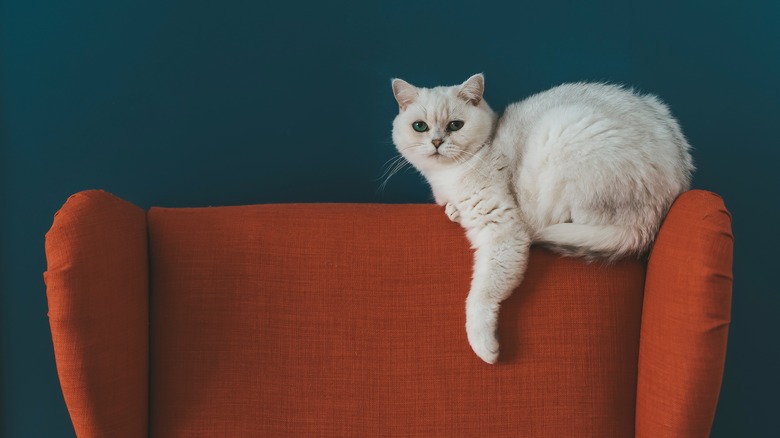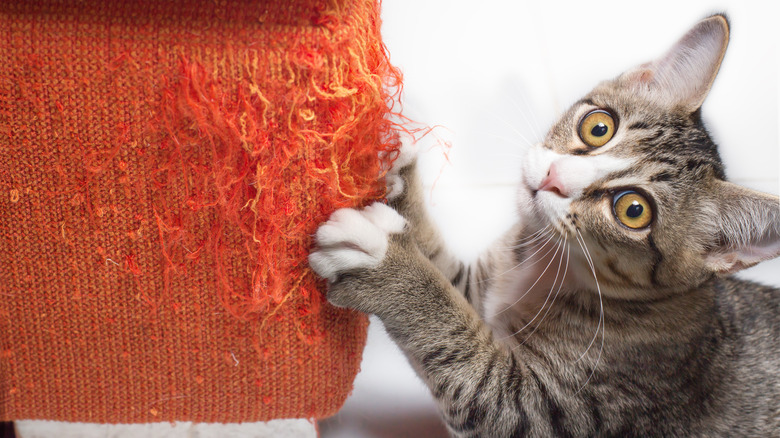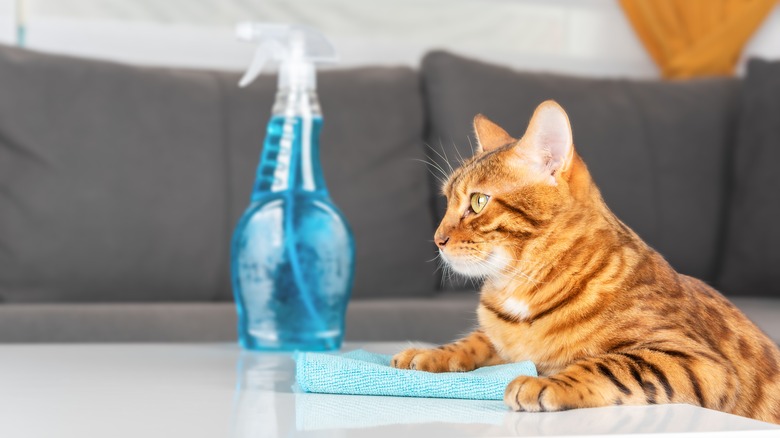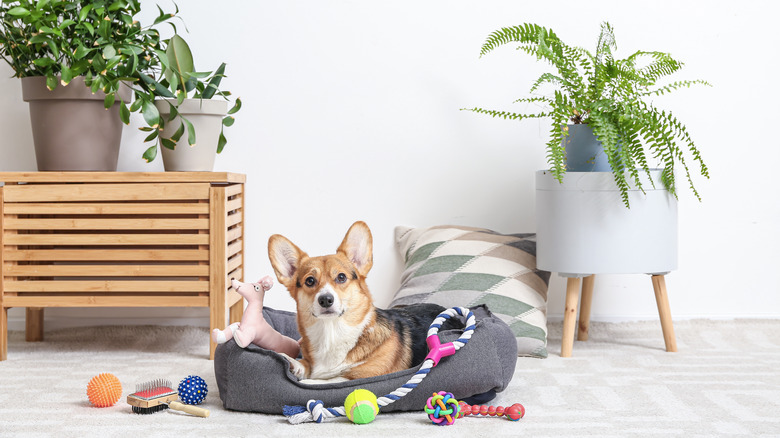5 Tips For Keeping Your Furniture Safe From Pet Scratches
Cats have an instinctive need to scratch the same way that dogs need to dig. Unfortunately, both activities can leave your furniture covered in scratch marks. Your pets don't realize that they're destroying your couches when they do this; they often do it out of boredom.
Wag! explains that dogs naturally dig in their beds to warm them up and move the fabric around, making it more comfortable. They may also dig in your couch if food crumbs or toys are in between the cushions. Cats scratch for a multitude of reasons. If they're feeling a lot of emotions, they may scratch what is nearby, according to The Humane Society of the United States. It also allows them to stretch their shoulders and to make their scent on the furniture since they have glands in their paws. Luckily, there are many ways to redirect your pet's natural instincts so they're not destructive.
1. Purchase a couch cover
Purchasing a cover for your furniture is an easy way to prevent scratches, but it has its downsides. Most notably, while your couch will be kept in immaculate condition, you won't be able to see its original material — which can prove frustrating if the fabric was one of the reasons why you chose the couch to begin with.
But, fortunately, there are many different slipcovers to choose from today, and you may find one you like the look of just as much. Note that thicker fabrics will better prevent pet scratches. Microfiber is the best material for a home with pets because it's hard to scratch or rip if your dog is digging in the couch. It's also easy to clean if your pet has any messes and will last a long time.
If you don't want to buy something new, though, you could also lay sheets over the sofa or have a designated pet blanket for them to dig on. This method will save your furniture because it's a physical barrier to scratches, dirty paws, and pet odor, according to The Goody Pet.
2. Use double-sided cat training tape
If your cats won't stop scratching your couch, a good way to train them not to is by using double-sided cat tape. This thick tape goes onto your furniture and prevents your cat from scratching it because they don't like the sticky feeling on their paws. You can use regular double-sided tape, but it may leave a residue. Look for cat-training tape to purchase at your local pet store.
To use this tape, you'll first need to clean the area that your cat has been scratching. This includes wiping it down or trimming loose threads. Apply the tape to the site, and you're ready to start training. XFastan recommends putting a scratching post or board near the furniture so your pet will redirect the activity. Once you see that your cat is using the post instead of your furniture to scratch, you can move it further away, toward the area where you want to keep it permanently. Then when you see that your pet is routinely using the post for scratching, you can remove the tape from your furniture.
3. Apply pet deterrent sprays
Using a pet deterrent spray is a way to keep them away from your furniture so they don't scratch it. These sprays are available at your local pet store, or you can mix your own DIY version. They work because cats and dogs have a strong sense of smell, so they won't want to approach and interact with objects that have a potent fragrance.
It's important when using these sprays that you do a patch test first in case it leaves a stain. Vetinfo.com recommends using a ratio of 1 part vinegar to 5 parts water in a spray bottle. You can use apple cider vinegar or distilled white vinegar. Another option is to make lemon or rosemary vinegar by soaking the fruit or herb for two to three weeks, according to Salty Canary. Then strain the vinegar and dilute it with water in a spray bottle. Once your solution is ready, spray it all over the furniture that your pet is scratching.
4. Lay tin foil
Tin foil is another way to prevent cats and dogs from getting onto your furniture and scratching it. Neither of these pets like tin foil because it feels odd on their paws. It also makes a loud noise when they touch it and is reflective, which scares them away. Since this method relies on your pet not being familiar with the material, it won't work if they're already used to you using tin foil around them.
If you use this on furniture like a dining room table or chairs, simply lay the tin foil over them. You'll need to cut the tin foil into sections larger than the cushions for a couch or lounge chair. Lay the foil over the cushions and tuck it down their sides. Pet Friendly House recommends doing this so your dog won't push the foil out of the way and continue to scratch the furniture.
5. Give them their own space
Giving your pets their own space is the nicest way to redirect their scratching off your furniture. However, it can be tricky if they prefer using your couch as a stretching post. Dogs often scratch out of boredom, so make sure that they have toys to play with and are getting enough mental stimulation. Providing them with their own bed near the couch is another method, according to Preventive Vet. To reinforce them to lay on their own bed, give them a treat whenever they choose it over the couch.
For cats, you should make sure that they have a cat tree, scratching post, or board. A crucial step is the location of these items. They should be in a spot that's easily accessible and visible to your cat, explains Cattitude Daily. If you put it in a place that's hard to get to, it's unlikely they will ever use it.





